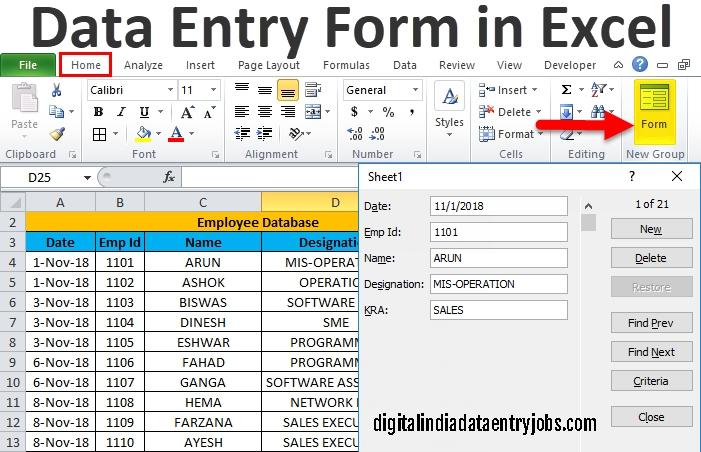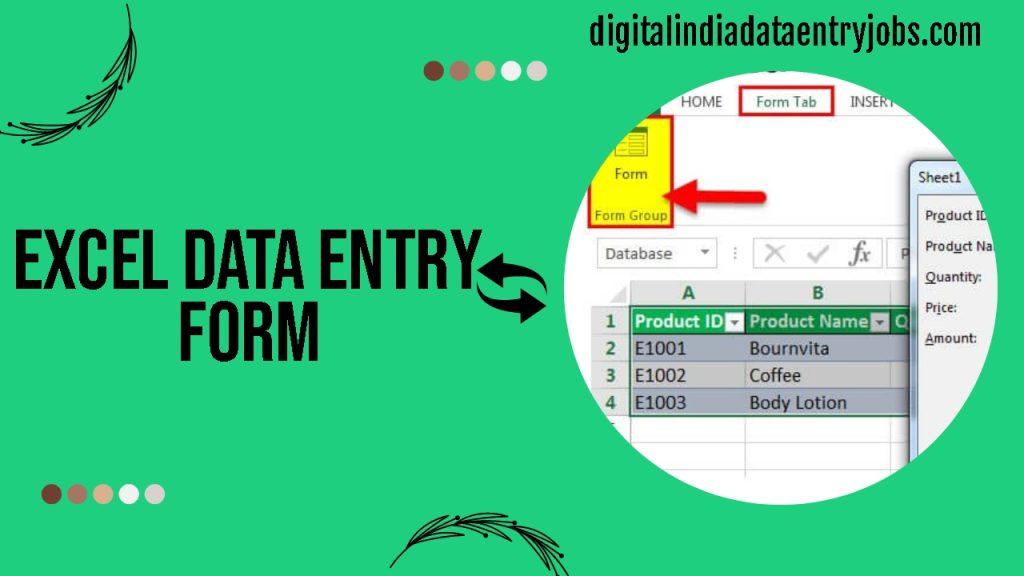Excel Data Entry Form:- Most individuals enter data into Excel spreadsheets in the conventional manner, which involves cell-by-column and row-by-row work. It is possible to utilize a customized data entry form to streamline the procedure and reduce its duration. You won’t have to scroll horizontally between columns, allowing you to concentrate on individual records one at a time.
Contents
How to Create an Excel Data Entry Form
- Step 1: To convert your dataset into a table, select any cell and press the Ctrl and T keys simultaneously.
- Step 2: Presently, select the Form Button from the Ribbon.
- Step 3: Your table will have an entry form with fields that match to the column headers when you press the Form button.
Within the dynamic realm of Microsoft Excel, there exists a sometimes disregarded jewel that has the potential to completely transform the way you enter, organize, and verify data in your spreadsheets: the Excle Data Entry form. You can maximize the potential of data entry forms and simplify spreadsheet processes even if you’re a beginning user.
Also Read:- Remote Data Entry Jobs, Mobilenumbertrackeronline, Nebsit Council
Excel data entry form
Unbeknownst to most users, Excel includes a unique form specifically designed to make data entry in spreadsheets faster, easier to use, and less prone to errors—especially when working with big worksheets.
How are Excel tables typically filled out by users? directly entering information into cells. You can scroll to the right and back to the table starting at different times, or you can scroll up to view the column headings. When dealing with big data sets, mistakes might happen, such as entering data in the incorrect cell.
You can ask Excel to show one row of data in a convenient dialogue box to make input easier. You may precisely add new records here, as well as update and modify the ones that already exist. Additionally, you can configure Data Validation to guarantee that entries that satisfy specific requirements are allowed exclusively.
Excel 365, Excel 2019, Excel 2016, Excel 2010, and Excel 2007 all enable data entry forms; Excel Online (Excel for the web) does not.
The Data Entry Form in Excel operates as follows:

Notes:
- There can be no more than 32 columns or fields on a data form.
- You cannot print a data form since it is a modal dialogue window. Furthermore, until the data form is closed, you are unable to print a worksheet.
How to add the Form tool to Excel
All versions of Excel 2007 through Excel 365 include the Form tool, but by default, it is hidden. In order to make it visible, you must first add the From button to either the Quick Access Toolbar or the ribbon, or both.
Following these procedures will enable you to add the Form tool to the Quick Access Toolbar (QAT).
- Select More Commands from the pop-up menu by clicking the small down arrow located at the far right of the QAT.
- Choose All Commands or Commands Not in the Ribbon under Choose commands from in the Excel Options dialogue box that appears.
- Click on Form after swiping down the list of commands on the left until you see it.
- To transfer the Form to the list of QAT instructions on the right, click the Add button in the center.
- To save the modifications and exit the dialogue, click OK.
All of your workbooks will have the Form icon available to you right now in your Quick Access Tollbar.
You’ve overcome the primary obstacle, believe it or not. Upon launching Excel and launching the Form tool, all it takes is one button click to create a data entry form for any table—new or old.
Tip: You may also position the Form tool on the ribbon in a similar manner. Please refer to the How to add a button to the Excel ribbon for comprehensive details.

How to make a data entry form in Excel
Only Excel tables with complete functionality can have a data entry form. All you have to do to get the form is enter your data in a table and press the Form button. Below are the specific stages in detail:
- Type the column headings in the top row of your spreadsheet as normal. You can skip this step if you want an input form for an already-existing data set.
- Click the Ctrl + T keys at the same time as you select any cell in your dataset. This will create a table by selecting all of the data.
- Click the Form button after moving the cursor anywhere in the table. Completed!
Let’s create this little table as an example to keep things straightforward:
Your table will instantly have an entry form with fields that match the column headings when you click the Form button:
The Excel input form features several buttons, as you can see. Below is a quick description of the functions of each button:
In addition to the buttons, you can navigate using the following keys:
- Tab – get to the next field.
- Shift + Tab – get to the previous field.
- Enter- create a new record and save the existing one.
Also Read:- IGR Maharashtra Public Data Entry, Typingspeedtestonline, scholarships gov
Add a New Record in the Data Form
Use the data entry form to add a new record to your table by following these steps:
- Choose a cell from your table.
- On the Quick Access Toolbar or ribbon, click the Form button.
- Select the New option from the input form.
- Enter the data in the relevant fields.
- Once finished, click the New button once more or press the Enter key. This will create a blank form for the following record and add the record to the table.
Tip: You can use the same keyboard shortcuts you use in your workbooks to rapidly enter specific information. As an illustration:
- Press Ctrl + ; to insert today’s date.
- Press Ctrl + Shift + ; to enter the current time.
How to search for records
Use the vertical scroll bar or the Find Prev and Find Next buttons to go through each record one at a time. Use the Criteria button to locate records that match specific requirements.
To find all the projects allocated to the Design department, for instance, enter Design in the Department field and click Find Next:
You can expand your search by using the wildcard characters. In the Project box, for example, put *skill* to find projects where the word “skill” appears anywhere in the project name.
Logical operators such as less than (\), greater than (>), equal to (=), and not equal to (\>) are helpful when working with dates and integers. For example, to go through the entries where the start date is before March 1, 2021, you may use the criteria “<1-Mar-2021” or “<3/1/2021”:
Note: There is no case sensitivity for criteria on a data form. Let’s say that “DESIGN” and “design” will also turn up while looking for the Design department.

How to update and restore records
Use the navigation buttons or criteria to access the record, edit any incorrect information, and then hit Enter to commit the changes to the table if any entry is out-of-date or includes incorrect information.
By selecting the Restore button, you can go back to the original record if you made any inadvertent modifications and haven’t yet hit Enter. To reverse the changes made to the table after pressing Enter, use the keyboard shortcut Ctrl + Z.
Data Entry Form Data Validation: How to Use It
You can configure a data validation rule for one or more table columns to limit user input to a certain type of data; your rules will be automatically applied to the data entry form.
We establish this rule, for instance, to restrict the Budget to values within a certain range:
The standard or your custom error alert will appear whenever someone tries to enter a value that doesn’t follow the rule you’ve set:
There is one drawback to using data validation with input forms: drop-down menus don’t show up in data entry fields. However, the limitations of a drop-down list remain in place even though it is not visible within the form. The form will reject a value that you enter if it is not in the list, just like Data Validation does by default.
Method for Opening a Data Entry Form in VBA
VBA can be utilized in situations where your users are unaware that the Form button even exists. offering them a map that takes them straight to the form is like to offering them a secret map.
To open the form, assuming the Current sheet has a table, all you need is one code line:
- Sub OpenDataEntrtyForm()
- ActiveSheet.ShowDataForm
- End Sub
But there is a vital disclaimer—the code above only functions in the following scenarios:
The table starts in A1 or
Your table is referred to by the name “Database” (a defiend name, not a table name).
- Sub OpenDataEntryForm()
- Dim nName As Name
- Range(“B2”).CurrentRegion.Name = “database”
- ActiveSheet.ShowDataForm
- For Each nName In ActiveWorkbook.Names
- If “database”= nName.Name Then nName.Delete
- Next nName
- End SubS
How to Insert and Run VBA code is a great resource for learning all about VBA.
Excel Data Entry Form not Working
The following troubleshooting advice may be useful to identify the precise issue if the Data form in your Excel isn’t working:
Too many fields in the Data form
You may encounter this issue while attempting to create a data form for a table with more than 32 columns.
Reduce the number of columns in the table or add a new column to divide your large table into several smaller ones in order to fix this mistake.
Cannot Extend List or Database
If Excel tells you that it cannot expand a list or database when you attempt to add a new row of data, it indicates that there is already data in your table, and adding a new record would overwrite it.
To fix this error, first make sure your table can extend downward by removing any data that may be below it.

Also Read:- Data Entry Jobs, Companycontactdetail, Uidaionlineaadharcard
FAQs
Q.) In Excel, what is a data entry form?
Ans. Data entry forms let you enter, edit, and handle information in an organized way. Especially when working with huge datasets, it offers a straightforward way to enter data into a worksheet, decreasing errors and improving the user experience.
Q.) What are the differences between manual and data entry forms?
Ans. Manual data input involves entering information one cell at a time into a spreadsheet, which can be error-prone and time-consuming. On the other hand, a data entry form offers a dialogue box interface that streamlines and makes the process easier.
Q.) What part does VBA play in forms used for data entry?
Ans. Data entry form-related chores can be automated with VBA. VBA gives you more freedom and control by enabling you to construct custom macros that open, navigate, and alter data inside data entry forms.
#Saras

